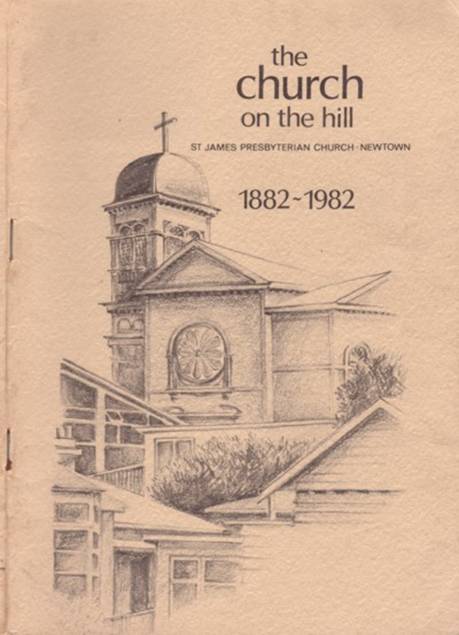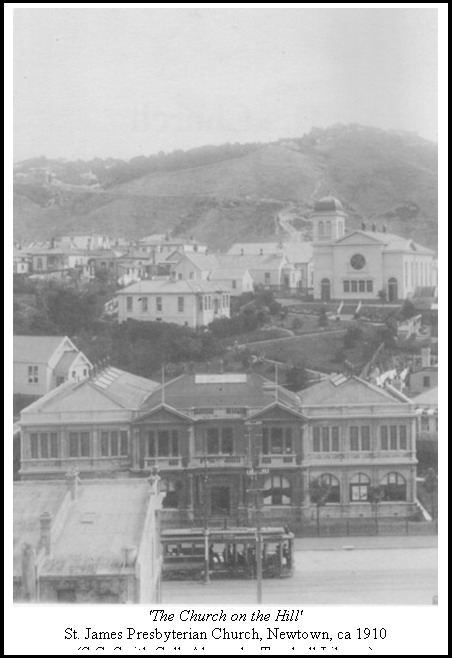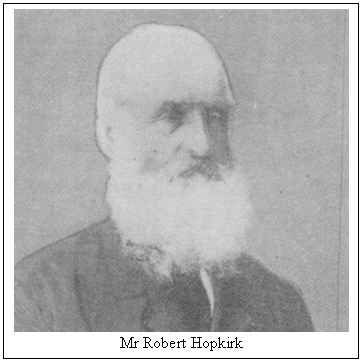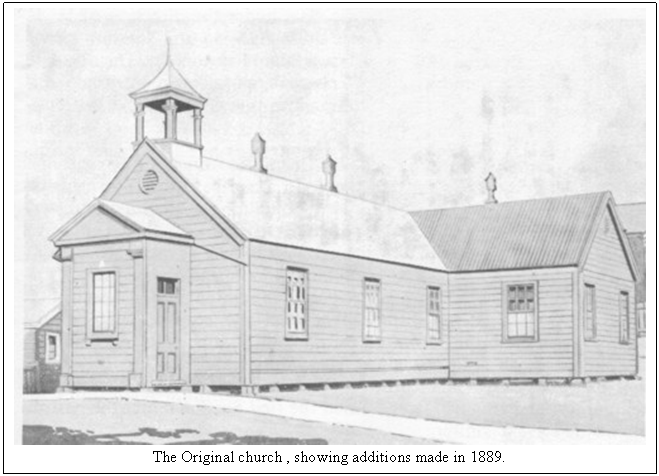Our thanks goes to St. James Presbyterian Church
and Rahul Joshi for supplying us with this wonderful information.
We have only included the early years of the church here.
For more information about St. James today, please visit their website at:
www.stjames.wellington.net.nz/
The
Church on the Hill
The
Story of St James Presbyterian Church
Newtown


Published by
St James Presbyterian Church
1982
Foreword
"We are pygmies, standing on
the shoulders of giants."
Perhaps our predecessors at St. James would not have called themselves giants.
Yet many of the people mentioned in this history were gigantic.
Mr Davidson deserved the name of Hercules. Few
ministries in
New
Zealand have been so long or so fruitful as
Mr Shirer's. They, and
the countless others not mentioned, didn't see themselves as anyone special.
But we - the whole present generation of St. James - have entered into the
inheritance of their labours. It is good that they
have had a chronicler so discerning, painstaking and at times eloquent, as
Helen Wilson. This history is essentially the result of her research, although
she'd be the first to acknowledge, and to exaggerate, the help others have
given her. It is a less than complete history, for two reasons that have nothing
to do with Helen. The first reason is the limitation of space. The Session
asked her to produce a history of only 70 or 80 pages. It would have been
entirely possible to have produced a history of several hundred pages. The
second reason is the shortage of material. We cast our net as widely as we
could, but the harvest of material, of hard evidence, has not been as great
as we had hoped. Many people haven't realised the
importance of their memories. Nonetheless, no effort has been spared to make
the record as accurate and as interesting as possible, within these
limitations. The present people of St. James, ourselves included,
realise our debt to the past; we use our heritage
weekly, daily. Yet our faces are turned to the future, not to the past. We
believe that, as we enter upon the second century of St. James, the same
Lord who guided and sustained those who passed this way will enable us all
to work together for His glory, and to bear a continuing witness here to
His good news. Let us all so work, so believe, and so live, that His work
may be done through us and by
us. Langi Sipeli,
Ian Ramsden.
13
September
1982.
Beginnings (1879-1888)
St. James Church,
Newtown, dates its foundation from 1882 because
that is when the first
Sabbath
School building was established. However our true
anniversary might be dated some three years earlier. On
28
January 1879,
Mr James Smith, congregational treasurer and founder
of James Smith's Department Store, brought before the
St.
John's
Session the desirability of establishing a congregational mission he had
already obtained subscriptions amounting to nearly £100 towards a
missioner's salary. It was agreed that 'in a city so large and so rapidly
expanding there is need for some special effort being made in addition to
the ordinary church agencies to maintain the influences of religion'.
A month later Mr Robert
Hopkirk was appointed City Missionary, to work
especially in the Te Aro and
Newtown
districts. He was instructed
to visit house to house, hold cottage prayer meetings, establish a district
Sunday School, and (if a suitable place could be
found) hold Sunday services, visit the hospital, and 'in other ways seek
to bring the blessings of the Gospel to those who might otherwise be neglected'.
The people of
St.
John's
felt justifiably pleased that amongst their own Session could be found someone
so suitably qualified to carry out this work - Mr
Hopkirk had been actively employed in Home Mission
work in his native
Scotland.
The outreach which followed showed
considerable foresight and not a little bravery. Although Newtown had been
divided into 'town acre' lots in 1839 when 100,000 acres of Wellington land
was drawn in London, 40 years later there was still little to support the
view that 'the city must eventually more and more extend itself' in this
direction. 'From
Newtown
Park to Clyde Quay a deep boggy stream wound
its sluggish way through a morass of flax, raupo
and tussock grass'. Thick scrub, farmland and market gardens surrounded the
suburb. Distinguishing landmarks were the Newtown Hotel and Messrs. Kitchen
and Son's soapworks, with the straggling road leading
to the 'Park' being the principal and almost only street. As well, records
of
St.
John's
Church tell of the unparalleled depression which had been experienced by
all classes of the community during 1879. The next ten years were difficult
ones and 'by 1888 the country was experiencing
rnass unemployment'.

It seems that
Mr Hopkirk found a ready
response amongst the Presbyterians of the district. As early as March 1879
the St.
John's
Managers had been asked to secure a place in which services could be held,
and a
Sabbath
School established. The Odd-fellows Hall in
Adelaide
Road,
which was found to be available for ten shillings a day, had the advantage
of being close to the (steam) tram terminus. It was decided 'not to open
a school there during the present winter, but to try and secure teachers,
that when the weather and roads were better, a commencement might be made'.
It appears that the hall was not, in fact, hired until mid-1880 - a sign
of the times being an effort to reduce the rental. The first record of a
service there is a note of a collection taken early in September. Representations
had already been made to Presbytery on the need to establish a separate
congregation in the
Newtown area. Although the records for this period,
until the
first
St.
James Minute Book opens in mid-1881, are incomplete, we know that four trustees
were appointed. Under the guidance of James Smith, James Wilson (builder
of the
third
St.
John's), James Barry and John MeLean, the 'town
acre' on
Adelaide
Road
was purchased in 1881 for £350. £175 had been collected towards
this sum and the remainder was left on mortgage at 8
percent.
On
21
June 1881 a meeting
was held at the
Hanson
Street house of Mr John
MeLean Snr (an elder
of St.
John's)
to appoint a committee for the purpose of establishing a Presbyterian Church
in the
Newtown district. The following committee was elected:
D Campbell, W
Lyttlejohn, J J MeLean
Snr, - Shaw, A Wilson, J
MeLean Jnr (Secretary)
and Joseph Hopkirk (Treasurer). It was decided
that building funds should be raised by means of a subscription - members
of the Committee were issued with passbooks, each to give as much as their
means would permit and also to make a vigorous canvass amongst their friends.
Fortyseven pounds ten shillings was subscribed
in the room, a sum probably close to a week's income for the members collectively
and a good indication of the earnestness of the men involved. The method
proved enormously successful, 136 friends subscribing a total of
£190.
With fund-raising well in hand, and
consent for building obtained from the site
trustees,, Mr Alex Wilson
was instructed to call for tenders to close at
noon on Tuesday 11 October. This rapid progress was fortunate, as a month
or two later a large increase took place in the price of building material.
For the reasonable price of £175 a Mr Charlton
erected a comfortable schoolroom with two classrooms capable of seating 180
worshippers. Mr Alex Wilson, a local dairy farmer
and the eponym of
Wilson
Street,
brought many practical skills to the congregation's building projects. To
prevent all unnecessary expenses, he had also prepared the plans and with
the aid of Mr John McLean and
Mr Reid superintended the erection of the schoolroom.
Other Committee members too, took time off from fund-raising to carry out
extra work. Modest arrangements were made for furnishings; seats were purchased
at auction for £4.10s, and the schoolroom was ready for occupation,
free of debt, a mere eight months from the Committee's first meeting. The
cost of insuring the building in the first year was
£1.
Appropriately, the Rev. James Paterson
from
St.
John's conducted the first service in the schoolroom, on the morning of
5
February 1882. The
evening service was conducted by Mr Grant from
Lower
Hutt.
The women of the congregation were responsible for the
organisation of the public tea meeting held to
mark the opening on the following Tuesday: Mr
Godber of
Cuba
Street
provided the 'teas' and it was decided to hold the meeting in the
Oddfellows Hall. The activity of the Presbyterians
of the district had been paralleled by the Anglicans and the Wesleyans. The
first service of
St.
Thomas's
Anglican Church was also held on
5
February 1882, and
Mr Joseph Hopkirk of
the St. James Committee was deputed to write to the Adelaide Road Wesleyan
Chapel Committee regretting that we had decided to hold our opening tea meeting
on the same night as theirs.
It must have been with no little sense
of achievement then, that the Committee called the first congregational meeting
a few weeks later, to report that its brief was near complete, and to express
the hope that our numbers will gradually increase and with God's blessing
upon our little church it will yet become a power in the
neighbourhood for much spiritual good'. An important
further move was taken in this direction when advice was sought from the
Rev. James Paterson regarding the achievement of the status of a 'preaching
station'. He provided the following encouragement: 'It is quite clear you
cannot remain in your present undefined position. You must go forward to
be formed into a regular church and in time to have a regular pastorate.
By all working earnestly and unitedly together
with God's blessing on your efforts a good strong congregation may soon be
formed.' The congregation's formal application proved most acceptable to
Presbytery who naturally found it reason for satisfaction that 'a step so
decided' should be taken 'toward the formation of a third charge in
Wellington'. A letter of
23
May 1882 from the
Rev. James Doull, Presbytery Clerk, informed that
our friend and mentor, the Rev. James Paterson, had been appointed Moderator.
Messrs. John McLean
(Hanson
Street),
James Smith and Robert Hopkirk were to form a
Provisional Session responsible for the spiritual oversight of the
congregation.

There had earlier been discussion on
a suitable name for the
Newtown congregation and it was a simple matter
of domestic organisation that brought an end to
this debate. With a communion roll formed and the first communion set down
for early August, attention was centred on the
printing of the communion cards. The Committee Chairman
(Mr John McLean Snr)
proposed that the cards should be headed St. James Presbyterian Church as
this was the original name given by the Trustees - three of the four Trustees
were themselves called 'James'. To this name, however, several of the members
objected, and the alternative 'Adelaide Road Presbyterian Church' was discussed
at length before our present name was endorsed.
6
August 1882 was something
of a red-letter day in the life of the new little congregation. Thirty-six
members partook of communion from a cup lent for the occasion by
St.
John's.
As well, the sacrament of baptism was administered to the child of
Mr Hercules Davidson, Committee member. We are
told that this occasion brought forth a very earnest' sermon from the Moderator,,
the Rev. James Paterson, based on John XII: 32 'And 1, if I be lifted up
from the earth, will draw all men unto Me.' Another first was the 'Entertainment'
put on by the newly-formed singing and music class under the direction of
Mr H Podmore. The charge
was a modest shilling a head and the sum raised exceeded the £8 needed
to buy a secondhand harmonium. The obstacle presented by the muddy winter
roads that ran between
Newtown and the city might have contributed as much
to this success as did the reputation of the fledgling singing
class!
With their first anniversary behind
them, the Annual Congregational Meeting in February 1883 undertook to examine
future prospects of the congregation., especially
relative to obtaining a qualified minister. For some reason,
however. The Church Extension Committee :chose
to overlook the congregation's expressed wish to hear as many students as
the committee could provide, before any appointment was made. Without
consultation, Mr James McNeil was appointed student
evangelist. Mr Robert
Hopkirk was dismissed in what was considered to
be 'unseemly haste' - an unwarranted recompense for one who had rendered
the congregation such sterling service. Messrs
MeLean Jnr, Davidson,
and Campbell resigned in protest. Happily, their withdrawal was only temporary,
and this trio later formed the first Session under the pastorate of the Rev.
W Shirer.
Student he may have been, but impecunious
he was determined not to be. Mr McNeil in June
1883 found himself put to the 'painful necessity' of informing the Committee
of Managers 'that unless you see your way to grant me such a salary as I
can live comfortably among you, I cannot remain much longer at Newtown'.
The Church Extension Cornrnittee had been paying
Mr MeNeil a salary of
£8.6.8d. monthly, and he required £12.10.0
to live 'comfortably'. Mr McNeil remained at St.
James until mid-September when he resigned to seek a charge as a
fullyordained minister. Having again set about
the business of obtaining subscriptions, the congregation decided that a
stipend of £200 could be managed. However, Mr
MeNeil declined the offer of a
call.
 The
Rev. James Kennedy Elliott had but recently arrived in this country, having
left his native
Ireland on account of the health of his wife, who
was suffering from haemorrhage of the lungs. He
was a forceful character, with the Irish 'gift of the gab'. When the congregation
approached him to ascertain whether the stipend offered would prohibit his
acceptance of a call,
he,replied that 'while
. . . the sum is small taking into consideration the cost of house rent and
the expense of living in this country, yet as other considerations weigh
with me, than those of a pecuniary character, the stipend offered, would
not of itself be an insuperable objection Encouraged, the congregation cabled
a call to Mr Elliott, temporarily domiciled in
Sydney. While Mr Elliott's response was not immediate,
because of his wife's health, accept he did, and St. James prepared to receive
its first full-charge minister.
The
Rev. James Kennedy Elliott had but recently arrived in this country, having
left his native
Ireland on account of the health of his wife, who
was suffering from haemorrhage of the lungs. He
was a forceful character, with the Irish 'gift of the gab'. When the congregation
approached him to ascertain whether the stipend offered would prohibit his
acceptance of a call,
he,replied that 'while
. . . the sum is small taking into consideration the cost of house rent and
the expense of living in this country, yet as other considerations weigh
with me, than those of a pecuniary character, the stipend offered, would
not of itself be an insuperable objection Encouraged, the congregation cabled
a call to Mr Elliott, temporarily domiciled in
Sydney. While Mr Elliott's response was not immediate,
because of his wife's health, accept he did, and St. James prepared to receive
its first full-charge minister.
On
16
March 1885, the Reverend
James Elliott was solemnly inducted into the pastoral charge of the congregation.
The sermon, described as 'suitable', was delivered by the Reverend Fulton
from 1 Peter 5:2-4. Assuredly the Annual Congregational Meeting held two
days later was a time for 'acknowledging with devout gratitude the goodness
of God towards us during the year'. A bell donated by
Mr David, or perhaps Daniel, (the records are
inconsistent) Robertson of the Phoenix Foundry now pealed out a welcome to
the Sabbath morning service and the well attended Wednesday evening prayer
meeting. The organ, purchased from
America, had arrived and was expected to enhance
greatly the contributions of Mr
Hazlewood and the choir. The
Sabbath
School had continued to prosper and under the
superintendency of Mr
Hercules Davidson, was able to declare itself independent of
St.
John's.
In optimistic mood then, Mr
Hazlewood's tent was borrowed for the traditional
tea meeting to welcome Mr Elliott, 'in the event
of more being present than could conveniently sit down to
tea.'
With a settled minister, the little
congregation moved confidently forward. At the end of May, John McLean,
Hanson
Street, and Hercules Davidson were admitted and ordained respectively as
the first Elders elected from the congregation. The St. James Presbyterian
Ladies Association was formed on 22 June 1885 with the following object:
'To co-operate with the Minister and Elders and under the guidance of the
Kirk Session to engage in works of usefulness, visiting the sick and those
who attend no place of worship, raising money for missionary and charitable
purposes and distributing tracts.' A Young Men's Christian Association was
formed, its meetings conducted initially by Mr
Elliott, who also prepared a syllabus of the subjects to be
studied.
Missionary contact was established
through the Rev. Mr Watt, a missionary in the
New
Hebrides, who was
invited to write a letter 'at least once a year' to be read in the
Sabbath
School or Prayer Meeting.
Our predecessors showed a liberality
in their approach to other denominations somewhat surprising for their time.
Perhaps this was a true reflection of the 'pioneering spirit'.
Mr Elliott was, in August 1885, appointed
convenor of a Presbytery committee to consider
'what steps should be taken to stir tip and quicken the spiritual life of
the members of the churches and to bring the careless and indifferent under
the influence and power of the gospel'. Their work resulted in a series of
evangelistic services which were held at St. James from March 1886. Pastors
who assisted Mr Elliott were drawn from the
Congregational, Baptist, and Wesleyan Churches. Preparatory services for
communion were also at times conducted by ministers of other denominations.
The evangelical meetings were apparently fairly well attended and 'though
they failed to bring in the class of people for whom they were principally
intended, those who took part in them undoubtedly received much spiritual
benefit'!
The congregation's membership had doubled
and thoughts began to turn to plans for extending the schoolroom. However
in September 1885 a problem arose. Mr Elliott informed
his office bearers that many representations had been made to him suggesting
the removal of the church to a more central position near town. He himself
thought that if it were possible to obtain a site about the Basin Reserve,
a considerable increase in the congregation would follow. After examination
by a sub-committee, which found against the proposal, the matter lay dormant
until the Annual Congregational Meeting at the end of 1886.
Mr Alex Wilson's presentation of three alternative
plans for enlarging the schoolroom (with costs) prompted discussion on the
merits of a shift closer to the town 'for the convenience of those residing
in that direction'. It was decided to leave the matter for examination by
the incoming Managers.
Mr Elliott's style of leadership was not always
acceptable to some of our democratically inclined forebears. To resolve the
question of where St. James should be sited, Mr
John MeLean
(Daniell
Street) submitted a form of paper which he proposed should be sent to each
member and adherent of the congregation who was entitled to vote.
When, as chairman, 'Mr Elliott
refused to allow the matter to be discussed, a
clamour of voices was raised in protest.
Our recorder states that the meeting closed with the benediction -, heavily
underlined! Happily, at the congregational meeting held a few days later,
'long and full discussion' of the matter was apparently
characterised by the 'utmost good feeling'. It
was resolved that St. James should continue in
Adelaide
Road.
On the following Sunday, April 15, Mr Elliott intimated
from the pulpit that he intended to resign. About half of the congregation
followed Mr Elliott, as well as half the office
bearers, including the senior elder, Mr John McLean
(Hanson
Street).
Both parties to this debate were to
be proved right. The future was to show the clear need for St. James in its
Adelaide
Road position, as well as for the
Kent
Terrace
Church where Mr Elliott
was to conduct an outstanding ministry spanning the next thirty-four years.
However the period which followed was to be one of doubt and struggle for
those who remained at St. James - for the first, but not the only, time in
our history, the Newtown Presbyterians considered 'putting up the shutters'.
Under the moderatorship of the Rev. David Rodger,
Lower
Hutt,
the little congregation persevered. The names of those who undertook pulpit
supply over the next six months are many, including our early friend,
Mr Robert Hopkirk. Towards
the end of 1886 Mr John
Cowie, M.A., a divinity student from the Free Church
of Scotland, was appointed by the Church Extension Committee and remained
until the end of May, when he was at his own request appointed to the charge
of the Halkett and Kimberley districts in Canterbury.
He was followed by the Rev. Jas. B. Smellie, also
on a 'temporary charge' basis.
When an informal congregational meeting
decided in September 1887 'that the people should unite and keep the church
open', Presbytery was asked to provide an Interim Session. Messrs J G W
Aitken, James Wilson, and Robert
Hopkirk proved a wise choice; all three had strong
ties with St. James and each took a personal and individual interest in the
little congregation. With the prospect of the arrival of a further 'temporary
charge' at the end of October, the bold step was taken of advertising the
church service in the evening papers - a method of attracting members of
which Mr Elliott had strongly disapproved.
Mr J B Finlay.was apparently
highly regarded and his labours seem to have been
greatly successful. Under his leadership St. James was in sufficient heart
by early 1888 to plan a future. Subscription cards were distributed to raise
funds for additions to the
Sabbath
School and agreement was reached on the need to obtain a permanent minister.
A misunderstanding prevented the calling of Mr
Finlay, and when the Rev. Wm Grant declined their
call, the congregation promptly and unanimously decided to call the Rev.
Wm Shirer, recently arrived from
Scotland, who had been helping out with pulpit supply.
On
18 September
1888,
at a service conducted by the
Revs. Paterson,
Ogg, and Fulton, the Rev. Wm
Shirer was ordained and inducted to the pastorate,
thus commencing a ministry which was to earn him the affectionate title of
the 'Grand Old Man of St. James'. Some forty years later John
MeLean of Daniel Street was to write that while
some of his memories of the early days were pleasant, many were otherwise,
but 'with the first appearance of Mr
Shirer, our troubles ceased'.
Return to Robert HOPKIRK page
Home Family
trees
This page last updated on April 24, 2006




 The
Rev. James Kennedy Elliott had but recently arrived in this country, having
left his native
The
Rev. James Kennedy Elliott had but recently arrived in this country, having
left his native